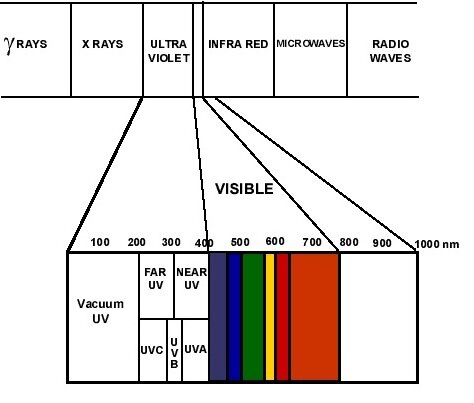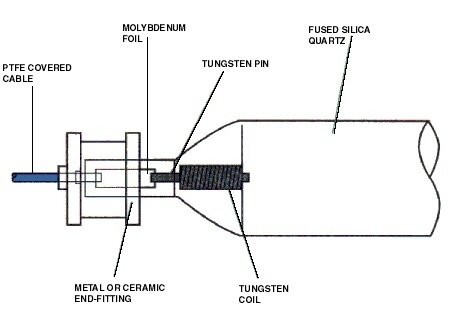About UV Curing:
The Electromagnetic Spectrum
UV On The Electromagnetic Spectrum
Ultraviolet reactive inks and coatings require a high intensity source of ultraviolet light to initiate a chemical reaction, curing the ink or the coating almost instantaneously. Ultraviolet light forms a small part of the electromagnetic spectrum which ranges from radio waves at the long-wave end, to x-rays and gamma rays at the short-wave end. The chart here shows how ultraviolet wavelengths fit into the electromagnetic spectrum.
Ways To Cure And Lamp Styles
The ultraviolet wavelengths most suitable for curing inks lie between 200 and 400 nanometers.
There are several types of lamp suitable for generating these wavelengths, the main ones being high-pressure mercury-arc lamps, electrodeless lamps and medium-pressure mercury-arc lamps.
The high-pressure mercury-arc lamp is generally constructed as a capillary type tube and requires a water jacket to maintain correct running temperatures. These lamps are limited to short lengths only and lamp life is usually less than 1,000 hours.
The electrodeless mercury-arc lamp has, as its name implies, no electrodes. An arc is established by the generation of micro-waves. These types of lamps are generally produced in two standards lengths, 6 inch and 10 inch.
By far, the most widely used is the medium pressure mercury arc lamp (an MPMA Lamp). This can be air or water-cooled and can be manufactured in a wide range of lengths. Single lamps of two metres long are not uncommon, and the working life of MPMA lamps can be expected to be well over 1,000 hours.
typical UV lamp construction
About Lamp Design
The body of the lamp is made from transparent vitreous-silica tube of various diameters and wall thicknesses. This material, referred to as quartz, has important properties vital to the efficient operation of an ultraviolet system. It has 90% transparency to ultraviolet light, whereas normal glass filters out all except the longer, weaker wavelengths. The surface temperature of an ultraviolet lamp under normal operating conditions is between 600°C and 800°C. Quartz is able to withstand these temperatures as it has a very low thermal expansion characteristic and high melting temperature.
The electrodes, from which the high voltage arc is sustained, are made from a tungsten rod overwound with tungsten wire. Tungsten is necessary to withstand internal arc temperatures over 3000°C. Electrodes must be designed carefully to ensure efficient, reliable operation and long lamp life. The parameters affecting this design are extremely complex.
Because of the extremely high running temperatures, and the low expansion characteristic of the quartz, the correct selection of a suitable material to connect the electrode inside the envelope, to the power supply on the outside of the envelope, is extremely important.
The material chosen here is molybdenum foil, which has a low coefficient of expansion and is capable of carrying the high voltage required to sustain a stable arc.
Additional electrical connections are made using high temperature wire. Electrical insulation at the end of the lamp can be achieved by the use of a ceramic end cap.
typical lamp spectral output
Spectral Output Of An MPMA Lamp
As has been stated earlier, the achievement of the precise wavelengths of ultraviolet light suitable for curing ultraviolet inks and coatings is very important if a system is to be highly efficient.
MPMA lamps emit not only ultraviolet light, but also visible light, and wavelengths in the infrared spectrum. In fact, all lamps emit approximately 20% ultraviolet light, 60% infrared light and 20% visible light. It is therefore important that when selecting a lamp, output in the ultraviolet spectrum should be closely examined.The ultraviolet spectral output is sometimes expressed graphically, showing the proportional output at the important ultraviolet wavelengths. A graph of a typical Primarc MPMA lamp is shown here.
Lamp Life
Medium-pressure mercury arc lamps do not normally fail suddenly, as do ordinary household light bulbs. Efficiency declines relatively slowly, until insufficient UV light is being emitted for the lamp to cure effectively. This decline is caused primarily by the deterioration in UV transparency of the quartz jacket, and depends on a number of factors:- lamp cooling efficiency, power rating, current rating of the electrodes, electrode cooling efficiency, contamination of the lamp's external surface (dust etc.) and switching frequency.
When correctly used, Primarc UV Curing Lamps are guaranteed to produce a high level of curing efficiency for at least 1,500 hours and, with proper handling, they will still be capable of delivering at least 80% of original output.
Get The Lamps You Need NOW:
quotes are free & we offer more than 8,000 designs to choose from



